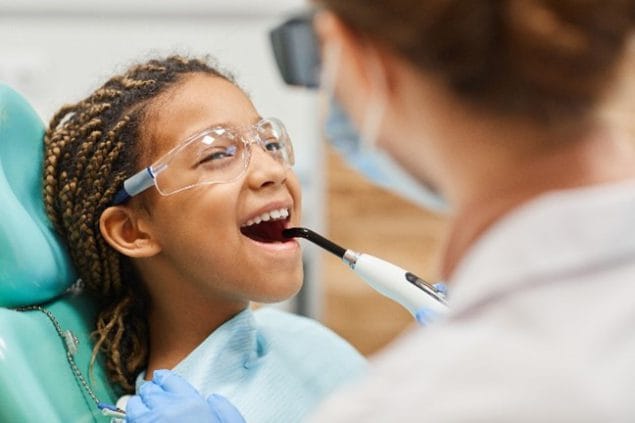School Sealant Programs Promote Health Equity
Increasing access to school sealant programs could improve oral health, especially for children at higher risk for cavities.

School sealant programs are a highly effective way to reach children who are at greater risk for developing cavities and less likely to receive private dental care.
Beginning in March 2020, the COVID-19 pandemic caused widespread closures of dental offices and school sealant programs, negatively impacting children’s oral health and their quality of life in the United States.1 In particular, Hispanic children and non-Hispanic Black children may lose twice as much quality of life over 4 years from untreated cavities compared to non-Hispanic White children.1
These disparities can be lessened by increasing sealant delivery through dental offices and school sealant programs to low-income families who do not currently have sealants. Placing dental sealants on about 40% of first molars among these children could eliminate the racial/ethnic disparities in excess cavities associated with the pandemic.1
Dental Sealants Protect Against Cavities and Keep Children in School
Cavities are the most common chronic disease of childhood in the United States.2 Untreated cavities can cause pain and infections that may lead to problems with eating, speaking, playing, and learning. Children who have poor oral health often miss more school and receive lower grades than children who don’t.3
Dental sealants are thin coatings painted on the chewing surfaces of the back teeth (molars) that can prevent cavities for many years. Sealants protect the chewing surfaces from cavities by covering them with a protective shield that blocks out germs and food. Once applied, sealants protect against 80% of cavities for 2 years and continue to protect against 50% of cavities for up to 4 years.4 Children aged 6 to 11 years without sealants have almost 3 times more first molar cavities than children with sealants.2

School Sealant Programs Reach Children at High Risk for Poor Oral Health
School sealant programs are a highly effective way to reach children who are at greater risk for developing cavities and less likely to receive private dental care. Programs are generally found at schools with a higher percentage of children eligible for federal free or reduced-cost meal programs. Although each state-coordinated program may be structured differently, school sealant programs typically provide sealants to children aged 6 to 11 years or in grades 1 through 5.
Increasing access to school sealant programs could reduce cavities, especially for children at higher risk for poor oral health. Compared with children from higher-income families, children from low-income families are more likely to:
- Have untreated cavities.5
- Have few or no dental sealants.5
- Not have had yearly dental visits.6
Programs that deliver sealants to children at high risk for cavities also save money. Each tooth sealed saves more than $11 in dental treatment costs.3 Applying sealants in schools to the nearly 7 million low-income children who don’t have them could prevent more than 3 million cavities and save up to $300 million in dental treatment costs.3,7
Challenges in Expanding Access to School Sealant Programs
School sealant programs are substantially underutilized. In a study of many CDC-funded states, one-third of states reported funding as a key challenge to expanding school sealant programs.8 Other barriers, as reported by states, were low Medicaid reimbursement rates and state practice acts that govern dentists’ supervision of dental hygienists. 8
However, almost 80% of states receiving CDC funding reported an increase in school sealant program coverage from 2013 to 2018.8 States can expand access to sealants by increasing the number of sealant programs or capacity to provide dental services.
What States Can Do
Without intervention, disparities in the oral health and quality of life among children based on family income or race/ethnicity will continue. States can increase support for school sealant programs by:
- Building partnerships with schools and dental and medical providers.
- Sharing information about dental sealants with school superintendents, principals, clinicians, and teachers.
- Providing incentives to teachers at schools with sealant programs to increase the number of consent forms returned.
- Learn more about school sealant programs, including what dental providers, school administrators, and parents can do.
- Learn more about the implementation of school sealant programs.
- Answer your questions about dental sealants.
- Learn how schools can improve students’ oral health.
- Scherrer C, Naavaal S, Lin M, Griffin SO. COVID-19 Pandemic Impact on US Childhood Caries and Potential Mitigation. J Dent Research. April 2022. DOI: http://dx.doi.org/10.1177/00220345221090183
- Institute for Health Metrics and Evaluation (IHME). GBD Compare Data Visualization. Seattle, WA: IHME, University of Washington. 2020. http://vizhub.healthdata.org/gbd-compare. Accessed January 30, 2023.
- Griffin SO, Wei L, Gooch BF, Weno K, Espinoza L. Vital Signs: Dental Sealant Use and Untreated Tooth Decay Among U.S. School-Aged Children. MMWR Morb Mortal Wkly Rep 2016;65:1141-1145. DOI: http://dx.doi.org/10.15585/mmwr.mm6541e1
- Community Preventive Services Task Force. Preventing Dental Caries: School-based Dental Sealant Delivery Programs. Atlanta, GA: US Department of Health and Human Services, Community Preventive Services Task Force; 2016. https://www.thecommunityguide.org/findings/dental-caries-cavities-school-based-dental-sealant-delivery-programs. Accessed July 21, 2022.
- Griffin SO, Wei L, Gooch B, Weno K, Espinoza L. Changes in dental sealant and untreated tooth decay prevalence and the estimated impact of increasing school-based sealant program coverage. MMWR. 2016;65:1141-1145.
- Griffin SO, Barker LK, Wei L, Chien-Hsun L, Albuquerque MS, Gooch BF. Use of dental care and effective preventive services in preventing tooth decay among US children and adolescents—Medical Expenditure Panel Survey, United States, 2003–2009 and National Health and Nutrition Examination Survey, United States, 2005–2010. MMWR. 2014;63(2):55–61.
- Centers for Disease Control and Prevention. Dental Sealants Prevent Cavities—Vital Signs website. https://www.cdc.gov/vitalsigns/pdf/2016-10-vitalsigns.pdf [PDF – 2.37 MB]. Accessed August 22, 2022.
- Patel N, Griffin SO, Linabarger M, Lesaja S. Impact of school sealant programs on oral health among youth and identification of potential barriers to implementation. J Am Dent Assoc. August 2022. DOI: https://doi.org/10.1016/j.adaj.2022.05.011